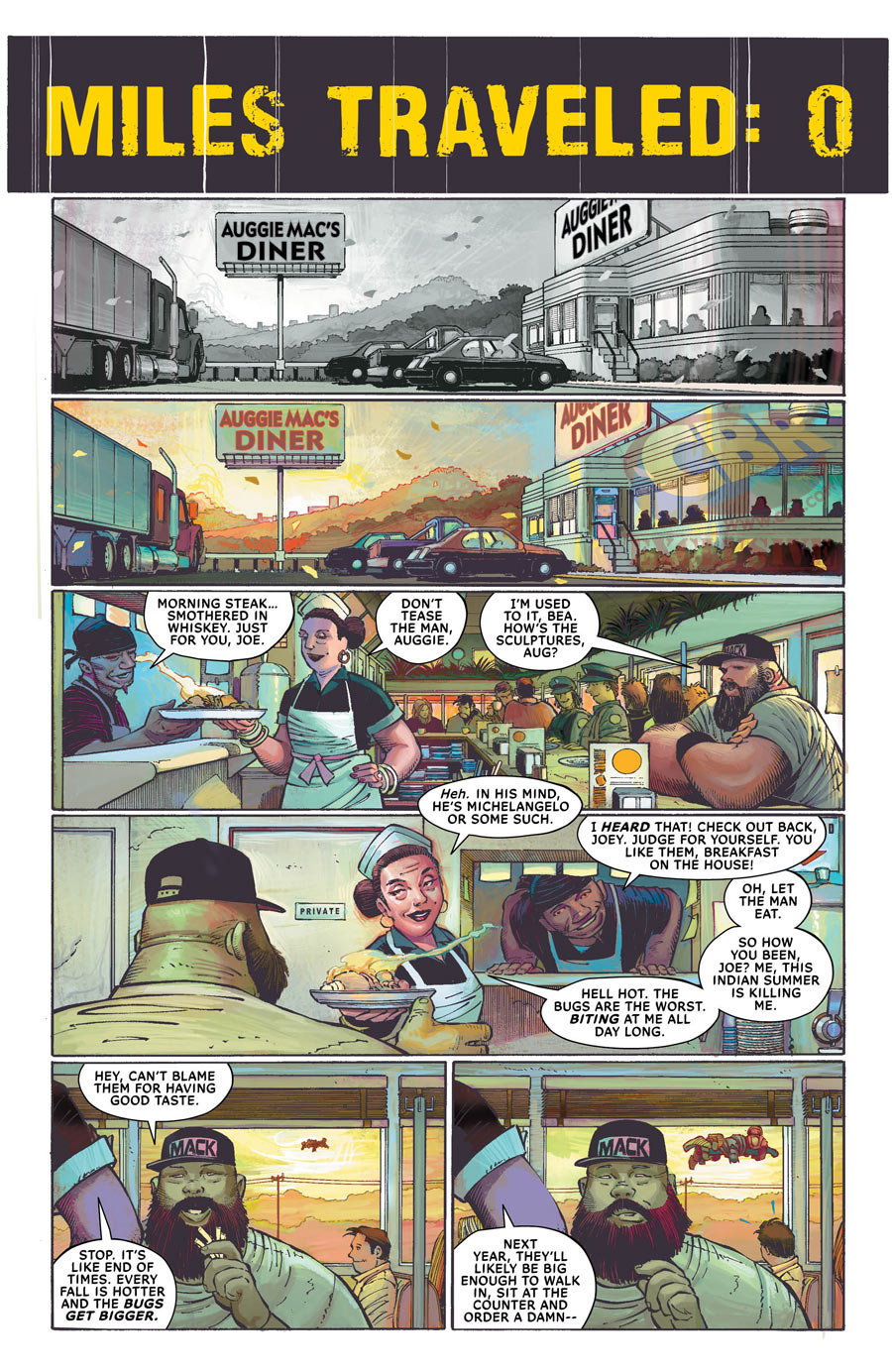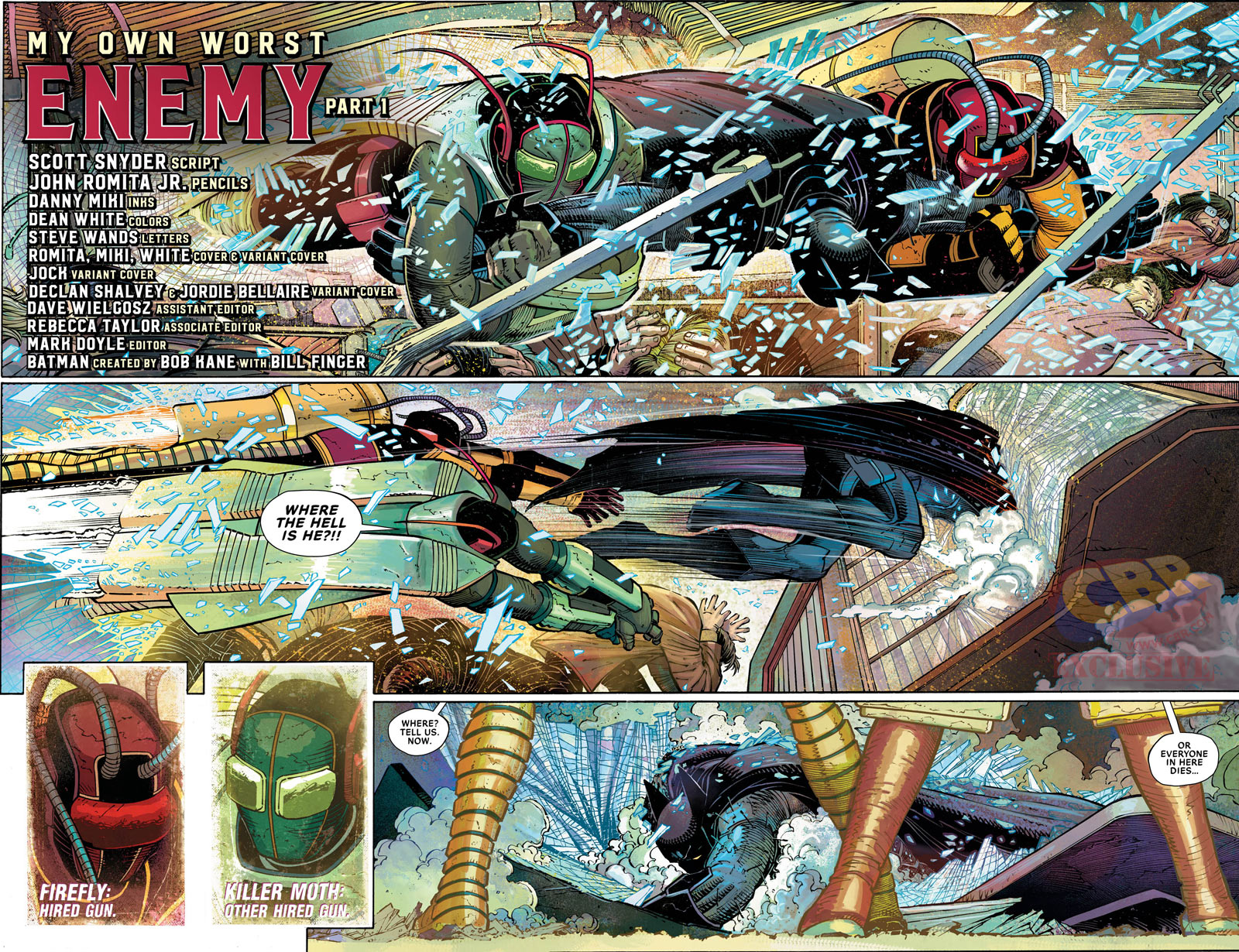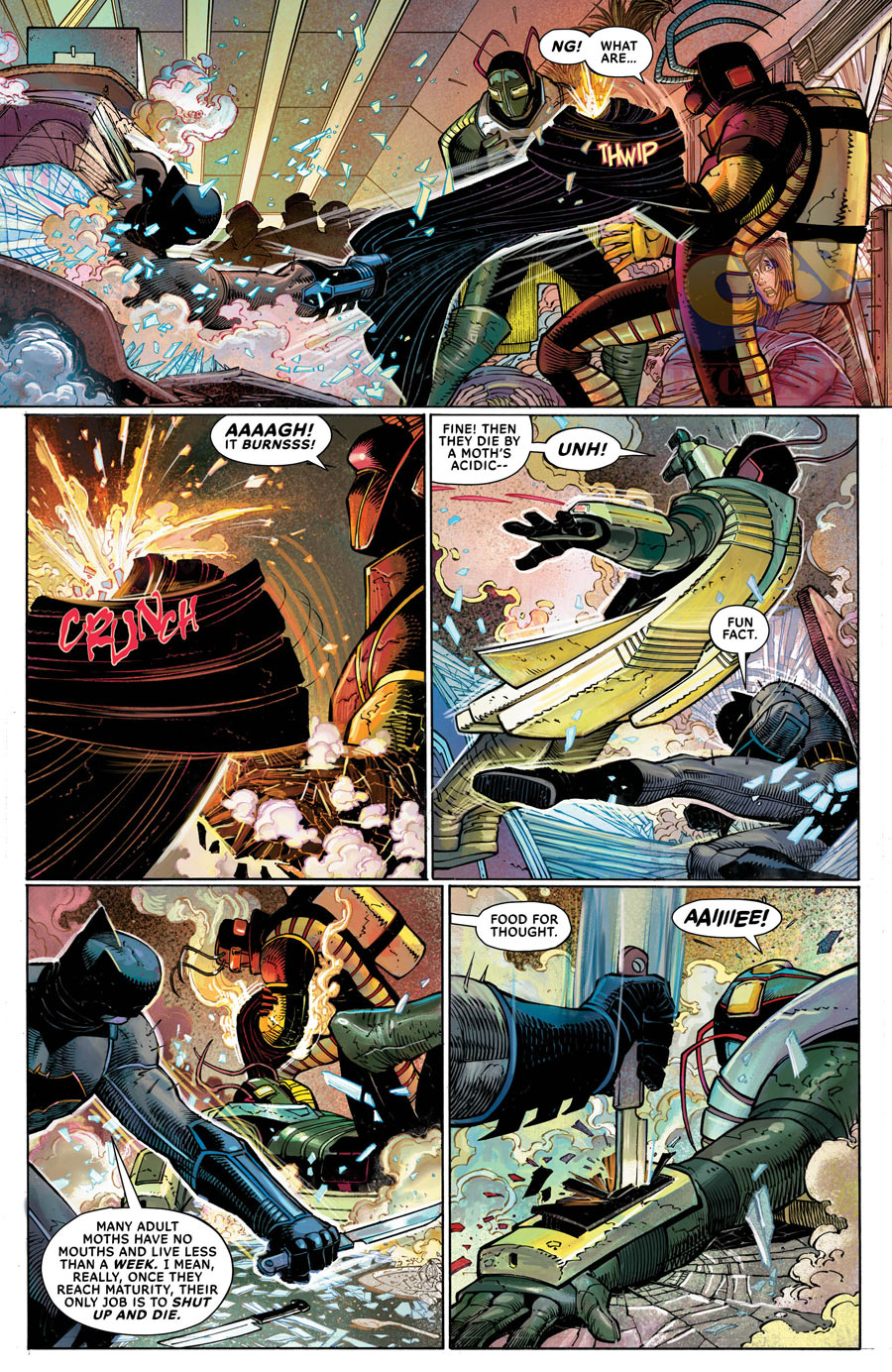“All Star Batman #1” comes out tomorrow. Here’s Bryan’s interview with writer Scott Snyder and artist John Romita, Jr.
This interview was edited for clarity.

Bryan Young: This has a very cinematic vibe, a lot of the work has that Grindhouse look. It’s very much The Raid meets The Transporter. But the look of it captures that cinema too. And I’m wondering if you guys could talk about that.
Scott Snyder: It was, the fun for me was trying to figure out how I could do something on “Batman” that I have never tried before and that we might not have seen before in the book itself or with the character and going back and thinking about the kind of story John and I would have fun on. We both really felt we wanted to do something that was personal and that we felt passionately about, but also was kind of high octane and fun. “Batman” can be so grim and so dark sometimes, and there are great interpretations of him that way, but I just felt one of the joys of working on Batman over the last five years was being able to reinvent him occasionally to be more about inspiration and about hope and bravery. So, here it was really, how do we even up the ante? And what it came down to, I think, was making a story where it would be wholly unfamiliar visually, setting wise, where [Batman] and Two-Face are engaged in this final bet between each other. Where Two-Face is saying, look, the people of this country, of this state, of this city, of the world right now, they all feel things falling apart, they all feel these challenges facing them that are inescapable and insurmountable and the sort of structures of law that will fall away soon. And what I see is a bunch of people waiting to be set free that are really out for themselves. We’re all villains deep down, we just don’t want to admit it and Batman’s like, I see you. And I counter. And I raise: People are heroes. So, here it became about sort of creating an aesthetic that would feel terrifying and fun at the same time. So that cinematic vibe is something that feels unfamiliar and surprising, but also, I think, inviting and kind of colorful and fun, which was what we were going for. Where it sort of underscores a lot of what we were going for in the story itself.
BY: It sounds like you got a little bit of a political commentary in there as well.
SS: Well, it’s not an overtly political story in the way that it doesn’t take any sides. My politics are personal and I’m pretty obvious about them on Twitter and on social media. But I try really hard to not make “Batman” a place where I sort of get a soap box. Instead, I try to use it as a place to talk more generally about personal fears and personal anxieties about the world. It’s very much about this being a moment where people are scared and, I think, when you’re facing challenges that seem intractable and really scary, about things that are huge and abstract. Batman was a figure when I was younger that dealt with very provincial problems, generally, and Gotham was the place that reflected very local problems in New York or cities around the country. Now, I feel like Batman is a figure that, sort of, goes up against these problems that we see in this very interconnected national and global forum. Everything from random violence and terrorism to all kinds of institutionalized issues. So, for me, it’s more about how do people react when they see the world at a crossroads when they feel scared by the world itself and by the problems in it, the immensity of the problems that they’re up against. Do we come together regardless of our political views and bring out the best of each other, whether our policy choices are at odds? Or do we sort of retreat into selfishness and sort of say, it’s every man for himself and I’m going to get mine? It is political, but it doesn’t take sides in that way. It’s much more about, I think, a moment right now that is a crossroads and it brings out the heroes and the villains in us in different ways.

BY: John, bringing out that hope, but also that cinematic vibe, how did you approach this? This is your second project taking on Batman?
John Romita, Jr: Yes. The term grindhouse was actually mentioned after I had gotten in on the series. I hadn’t considered that look until it was mentioned to me by Scott. I love the idea and it made perfect sense with this element being out in the middle of this arid heatwave, dry loads with nothing on the sides, and that’s actually the metaphor for the, that helped assist with the, of Batman. I mean, he’s out in the middle of nowhere. Visually, there’s not a whole lot you can do. It’s basically meat and potatoes on this because there’s no buildings, there’s no shadows. Although we go through a couple of railroad tunnels and you get some shadows. It’s well lit most of the time and you can’t hide. You can’t fake, you can’t hide, you got to do what you have to do. And I think that it’s a great reflection of the story. That’s basically what Batman is, in the trouble, that’s the trouble he’s in. He’s, there’s no hiding. And that’s exactly what Two-Face is doing to him. You are, you are a sitting duck, my man, and I’m going to bring all the shots at you. And that’s exactly the story. And I love it. It’s a great challenge.
BY: I’ve talked to you both before, at different times. John, you when you were working on Kick-Ass. Scott, we’ve talked a hundred times. But, one thing that you both talked about separately is the quality of the creator you’re working with. And I’m wondering if you both talk about the collaboration between the two of you.
SS: John is someone I’ve been dying to work with for a long time. And he’s one of my absolute favorite artists ever. So, it really was about figuring out the right project. When we first met, the great thing was, he was right down the street. Literally, like, a mile away from me. When we first met up, we met up in town, had a couple beers and talked the story. The important thing, I think, for both of us and this was an immediate thing we started saying the first time we talked, was to have a project that we both felt would allow us to shine as a team and also do something that hasn’t been seen by us before and be in a place that was exuberant and fun. I didn’t want to, John has a name at this point, where, anything he does is going to sell well from go. And, of course, I say to DC, hey, I’m really dying to work with John, they’re like, great, anything Batman does, of course, will sell too. But the important thing was to a find a project or story that would be something we both felt really passionate about and that we both felt was surprising. So, I can’t say enough good things about working with John and also with Danny [Miki] and Dean [White]. They are so terrific. It really is collaborative. Ultimately, the thing is, I say this to them privately but I would say it publicly too. It’s a hundred percent true. They make me such a better writer because I see the pages and the art come in and it’s so much better than anything I imagined. And I thought I imagined it well. It makes me up my game constantly. And it’s the best sort of relationship in that regard. We talk and we text and we email all the time, too. Anytime I have a question or John has an idea or any of that stuff we go back and forth. I would work with John really from here forward. I hope we get to work on lots of things for a really really long time.

JRJ: I don’t know how to top that. But, in my limited eloquence, I can only say, there’s four guys working on this. Three artists and writer. Although, Scott’s sensibilities as a writer translate beautifully, visually. Danny Miki and Dean White are artists who happen to be color and ink artists. But we go back and forth through emails. Dean, I’ve worked with Dean for a very, very, very long time and invariably, he will send a reaction back to me about the pages, whether it’s good or a curious question, like, did you do this for this reason and so on? Almost as if he’s trying to soak up that feeling. We also react to his work and Danny’s work. So, I have two other guys backing me up. And they claim they got me backing them up. And it works that way. I had never imagined working with Scott before a couple of years ago. Coming over to DC was an invigoration completely. I got a chance to work with Geoff Johns, and now Scott. I have been so lucky with the writers I work with, everybody from Neil Gaiman and Mark Millar and now Scott. And there is one common thread and it’s that they enjoy storytelling. And, with a Romita there’s no such thing as an ego because of my father and my brother, they would smack the crap out of me if I showed an ego. It’s not allowed. But if I were to have a moment of ego, I would say I’m proud of my storytelling. And the writers that I work with feel strong about my storytelling. What it allows them to do is relax and say, this is what I’m giving you whether it’s literally a script or an amalgam, a combination hybrid of script and plot and say, here’s the dialogue, flow with it and if there are any alterations I’ll change the dialogue to put into what we do. So, it’s not set in stone. If I were twenty-five, it might be different. Scott is the more experienced one, he might have to dictate. But unfortunately or fortunately, I’m older than Scott and I’m able to handle whatever he throws my way. And he says, and Neil Gaiman said it, and Millar said it, whatever you send me, I’ll change on the fly. Scott pretty much did that too. And that allows me a freedom and it allows them to see things maybe they hadn’t considered. But I still want them to send me their opinions. And Scott sends me what he has in his mind and I don’t want that stunted in any way. But he sends me what he has in his head and visually it works out, but I can see something different so I add to it and he will adjust it on the fly. It’s a great collaborative effort. And egos are gone. There is no such thing. Because, if he says to me, I think you should have done this, I will listen to it and I will consider it and change it if he is right. And sometimes he’s right and sometimes he’s not. But it’s still this nice collaborative back and forth. You can’t be a stiff asshole and be an artist or a writer in this business. Because you have to listen to everybody’s opinions. Sometimes they’re right. And even readers will come up with ideas. And I have to listen. My ears have to be open and I have to keep my feet on the ground. And that’s the thing about this business.
BY: Well, the collaboration, I had a chance to read the first issue, the collaboration is certainly working very well.
SS: So you liked it?
BY: I did. I really dig the kind of classic cinema vibe, the Grindhouse thing, but also the more modern sensibility it has. It’s unsettling to, on a natural psychological level, to see Batman like that, out during the day in a desert.
JRJ: Exactly. The character does lend itself toward this type of visual. Because he doesn’t have the superpowers. He doesn’t shoot anything at you, other than a couple of lines and some darts or something. The down-to-earthness lends itself toward this Grindhouse look and that’s why this setting is perfect. And I wouldn’t have considered it until Scott mentioned it. It’s brilliant. Absolutely brilliant.

BY: And I have to say, and I don’t know how much you want to talk about this, that moment with Alfred. And I’m assuming you both know the one I mean.
SS: Yeah, yeah.
BY: It was heart wrenching, but if you want to come up with just comments on that.
SS: It was just a dream. No, it was, to me, it’s deeply about the things we hide from each other. Batman is saying, you might think, Two-Face, that we hide the worst of ourselves, but, sometimes we hide the best and you’ll see characters come into the story later that are heroic in private ways, the way Batman is. On the other hand, what Two-Face is saying, you don’t even see the side of people, because you refuse to look at it, that’s ugly, the side of their face that is right there in the mirror all the time. I kept trying to think, what can I do? What can I do that isn’t just the same, well, Harvey used to be his friend and Harvey turned on him. I wanted to avoid the origin entirely and do a fully modern Two-Face story here. And it came down to, well, how do you hurt Batman the worst? What if somebody has a secret? Who could have a secret that’s really really close to him that would be the most painful for him to realize that he doesn’t know people as well as he thinks he does. Everybody in this story has secrets, but that one is one of the real live wires that goes to the end of the arch.
BY: And what about portraying moments like that and trying to show the duality of people, visually, especially people like Alfred.
JRJ: Well, visually, it implies to me, first, I love reading a story from the writer and then like my mouth opens and up and I go wow, I’ll be a son of a bitch, that’s a great idea. I love being surprised by a writer. You have to be a little bit of a corny actor and a little bit of a ham to storytell and choreograph scenes like that we’re talking about. And act it out yourself, maybe even in front of a mirror to see expressions. Because you can only buy yourself some time as a choreography type guy and then get to a scene like this and struggle with it. You have to really learn from that, from past issues and stories, you have to be a little bit of an actor, you have to be a little bit of a ham to think about what that conversation would be like, what that moment would be like. And you can’t just lower the head and close the eyes and have a tear running down a cheek. There are differences and there are more variations on a scene like this than are in battle fights. I think you learn. You watch a lot of films. We’re both cinephiles. And you see things like that. Maybe you experienced it with family members and watch reactions and think about what you would do in the moment you find something out like that. That’s basically it. You draw from experience. You can’t draw from previous artists or previous writers in this business. This kind of scene you have to draw from personal or from film or to that effect. It kind of is, I wouldn’t be able to explain it to a younger artist what they look like themselves and thought for themselves. It would be hard to describe. I’d have an easier time explaining the prolog or a fight than this kind of moment. But that’s a great question. And I love the fact that I was shocked by that. That’s a testament to Scott.
SS: I love the fact that you act it out and I act it out. If anyone ever videotaped us or saw us when I’m like “Well, Master Bruce.”
JRJ: I have a mirror. And, unfortunately, that’s what I use it for. And that’s the truth. And I can see every little hole in my face and every scratch and mark and, oh, my teeth are so crooked, I got a big nose. I’m getting old. But, you still need the mirror. You still need the mirror to help you out on emotional scenes like that.
All Star Batman #1 comes out tomorrow in comic book stores across the country.
You can read the full interview with Scott Snyder and John Romita, Jr. at Big Shiny Robot!
Bryan Young is an author and professional nerd. He writes for StarWars.Com, Big Shiny Robot! and others. His most recent novel is “The Aeronaut” and he also wrote “A Children’s Illustrated History of Presidential Assassination.” He also podcasts on the Full of Sith show as well as Fauxthentic History.